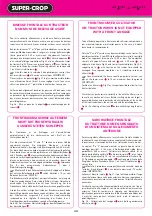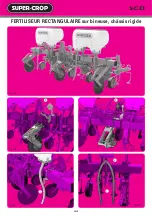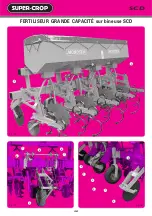
RÉGLAGE DU DÉBIT D’ENGRAIS
A L’HECTARE
Pour un épandage régulier et précis de l’engrais, n’utiliser que du granulé de bonne qualité.
FERTILISEUR AVEC ENTRAINEMENT A 1 ÉTAGE - Fig 79
(Bineuse avec fertiliseur plastique, sans équipement ray-grass)
I - Se placer sur le rapport A1 (Pignon A : 35 dents et 1 : 12 dents)
II - Mettre un peu d’engrais sur une sortie pour alimenter 1 tuyau- Fig. 80 (si le rang est alimenté par 2 tuyaux,
mesurer sur 2 sorties - Fig. 81).
III - Amorcer le système par quelques tours de roue motrice
IV - Faire 20 tours de roue motrice, puis peser l’engrais récupéré sur la (ou les) sortie.
V - Appliquer la formule suivante : 40 000
x poids mesuré (en g.)
Inter-rangs (cm)
Vous obtenez le poids à l’hectare, et vous déterminez la colonne du tableau correspondant au rapport utilisé.
Exemple : * Inter-rangs de 80 cm
* Poids mesuré 195 g. (sur rapport A1)
40 000 x 195 = 97500 g./Ha = 97,5 Kg/Ha (= 100)
80
On utilise la colonne "7" Fig 82 avec un choix de 100 à 500 Kg/Ha.
FERTILISEUR AVEC ENTRAINEMENT A 2 ÉTAGES - Fig. 83
(Bineuse avec fertiliseur tôle, ou avec équipement ray-grass)
I - Se placer sur le rapport A1 (Pignon A : 35 dents et 1 : 12 dents) sur l’arbre intermédiaire 3 , rester au
rapport 1/1 (utiliser les pignons 25 dents et 25 dents - Fig 83).
II - Mettre un peu d’engrais sur une sortie pour alimenter 1 tuyau (ou 2 selon le cas)
III - Amorcer le système par quelques tours de roue motrice
IV - Faire 20 tours de roue motrice, puis peser l’engrais récupéré sur la (ou les) sortie.
V - Appliquer la formule suivante : 40 000
x poids mesuré (en g.)
Inter-rangs (cm)
Vous obtenez le poids à l’hectare, et vous déterminez la colonne du tableau correspondant au rapport utilisé.
Exemple : * Inter-rangs de 80cm
* Poids mesuré 195 g.
40 000 x 195 = 97500 g./Ha = 97,5 Kg/Ha (= 100)
80
On utilise la colonne "7" - Fig. 84 avec un choix de 100 à 500 Kg/Ha et un choix de 50 à 135 Kg/Ha avec le
rapport intermédiaire 1/2 pignons 12 et 25 dents - Fig 83. Le tableau Fig. 85 permet de vérifier si le choix du
débit est correct. Faire 100 m, peser l’engrais récupéré sur un rang, comparer sur le tableau.
Exemple : Inter-rangs 80 cm, pour 110Kg/Ha on doit peser 880 g./ 100 m. Les réglages indiqués ne sont
qu’indicatifs ; un contrôle à la mise en route est obligatoire.
SCD
41
ADJUSTMENT OF THE FERTILIZER
OUTPUT PER HECTARE
For a regular and precise fertilizer placement, use only high quality granulates.
FERTILIZER WITH 1 LEVEL DRIVE (Fig. 79)
(Cultivator with plastic fertlizer hopper, without Ray-grass equipment)
I - Position on the A1 ratio (sprocket A : 35 teeth and 1 : 12 teeth)
II - Put a little of fertilizer on an outlet, enough to feed 1 hose - Fig. 80 (if the row is fed by 2 hoses, measure
on 2 outlets - Fig. 81)
III - Action the system by a few drive wheel rotations
IV - Make 20 rotations with the drive wheel, then weigh the fertilizer recuperated on the outlet(s).
V - Apply the following formula : 40 000
x quantity weighed (in gr)
Inter-row (cm)
You obtain the weight per hectare and you determine the column in the chart corresponding to the ratio used.
Example : * Inter-row = 80cm
* Quantity weighed = 195 gr (on the A1 ratio)
40 000 x 195 = 97500 gr/ha = 97,5 Kg/ha (= 100)
80
The column n° "7" Fig 82 would be used with a choice between 100 and 500 Kg/ha.
FERTILIZER WITH A TWO LEVEL DRIVE (Fig. 83)
(Cultivator with sheet metal fertilizer hopper, or with ray-grass equipment)
I - Position on A1 ratio (Sprocket A = 35 teeth and 1 = 12 teeth). On the intermediate shaft 3 , remain to
the 1/1 ratio (use the 25 tooth and 25 tooth sprockets Fig. 83)
II - Put a little fertilizer on 1 outlet to feed 1 hose (or 2 depending on the case).
III - Action the sytem by a few drive wheel rotations.
IV - Make 20 rotations of the drive wheel, then weigh the fertilizer recuperated on the outlet(s).
V - Apply the following formula : 40 000
x quantity weighed (in gr)
Inter-row (cm)
You obtain the weight per hectare, and you determine the column of the chart correponding to the ratio used.
Example : * Inter-row = 80cm
* Quantity weighed = 195 gr
40 000 x 195 = 97500 gr/ha = 97,5 Kg / ha (=100)
80
The column n° "7" would be used and a choice between 50 to 135 Kg/ha with the intermediate ratio 1/2,
sprockets 12 and 25 teeth - Fig 83. The chart on Fig. 85 enables to check that the choice of the output is
correct. Do 100m, weigh the fertilizer recuperated on 1 row, compare with the chart.
Example : Inter-row = 80 cm, for 110 Kg/ha, we must weigh 800gr/100m. The adjustments given are only as a
guide. Always double check when starting up the machine.
EINSTELLUNG DER DÜNGERMENGE
PRO HEKTAR
Um eine regelmäßige und präzise Streuerung des Düngers zu erreichen, benutzen Sie nur Granulat von guter
Qualität.
DÜNGERSTREUER MIT 1-STUFIGEM ANTRIEB - Abb. 79
(Hackmaschine mit Kunstoff-Düngerstreuer, ohne Ray-Grass-Ausrüstung)
I - Benutzen Sie das Verhältnis A1 (Zahnrad A : 35 Zähne und 1 : 12 Zähne)
II - Geben Sie Eine kleine Menge Dünger in einen Auslauf, um 1 Schlauch zu versorgen - Abb. 80 (wenn die
Reihe durch 2 Schläuche versorgt wird, messen Sie die Menge auf 2 Ausläufen - Abb. 81).
III - Starten Sie die Mengenzufuhr durch ein paar Umdrehungen des Antriebsrads.
IV - Nach 20 Umdrehungen des Antriebsrads wiegen Sie den auf dem bzw. den Ausläufen ab.
V - Wenden Sie die folgende Formel an : 40 000
x gemessenes Gewicht in Gr
Reihenabstand (cm)
Sie erreichen das Gewicht pro Hektar und Sie bestimmen die dem benutzten Verhältnis entsprechende Spalte
der Tafel.
Beispiel : * Reihenabstand von 80cm
* gemessenes Gewicht 195 Gr (auf Verhältnis A1)
40 000 x 195 = 97500 Gr/Ha = 97,5 Kg/Ha (= 100)
80
Man benutzt die Spalte "7" Abb. 82 mit einer Wahl von 100 bis 500 Kg/Ha.
DÜNGERSTREUER MIT 2-STUFIGEM ANTRIEB – Abb. 83
(Hackmaschine mit Blech-Düngerstreuer, oder mit Ray-Grass-Ausrüstung)
I - Benutzen Sie das Verhältnis A1 (Zahnrad A : 35 Zähne und 1 : 12 Zähne) auf der Zwischenwelle 3 .
Bleiben Sie auf Verhältnis 1/1 (benutzen Sie die Zahnräder 25 Zähne und 25 Zähne – Abb. 83).
II - Geben Sie Eine kleine Menge Dünger in einen Auslauf, um 1 Schlauch (oder 2 nach Bedarf) zu versorgen.
III - Starten Sie die Mengenzufuhr durch ein paar Umdrehungen des Antriebsrads.
IV - Nach 20 Umdrehungen des Antriebsrads wiegen Sie den auf dem bzw. den Ausläufen ab.
V - Wenden Sie die folgende Formel an : 40 000
x gemessenes Gewicht in Gr
Reihenabstand (cm)
Sie erreichen das Gewicht pro Hektar und Sie bestimmen die dem benutzten Verhältnis entsprechenden Spalte
der Tafel.
Beispiel : * Reihenabstand von 80cm
* gemessenes Gewicht 195 Gr
40 000 x 195 = 97500 Gr/Ha = 97,5 Kg/Ha (= 100)
80
Man benutzt die Spalte "7" Abb. 84 mit einer Wahl von 100 bis 500 Kg/Ha und einer Wahl von 50 bis 135 Kg/Ha
mit dem Zwischenverhâltnis 1/2 Zahnrad 12 und 25 Zähne - Abb. 83. Durch die Tafel können Sie prüfen, ob die
Wahl der Mengenregulierung richtig ist. Fahren Sie 100 m. Wiegen Sie den auf einer Reihe erzielten Dünger
ab und vergleichen Sie mit der Tafel.
Beispiel : Reihenabstand 80cm, bei 110 Kg/Ha sollten Sie 880 Gram/100 m abwiegen. Bitte prüfen Sie bei der
Inbetriebsetzung, da die angegebenen Einstellungen nur Richtwerte sind.
REGOLAZIONE DELLA QUANTITÁ DI
FERTILIZZANTE PER ETTARO
Per un spandimento regolare e preciso del fertilizzante, utilizzare soltanto granulato di buona qualità.
FERTILIZZATORE CON AVANZAMENTO AD 1 PIANO – Fig. 79
(Sarchiatrice con fertilizzatore plastico, senza equipaggiamento loglio)
I - Posizionarsi sul rapporto A1 (Pignone A : 35 denti e 1 : 12 denti)
II - Mettere un poco di fertilizzante su una uscita per alimentare 1 tubo – Fig. 80 (qualora la fila sia alimentata
da 2 tubi, misurare su 2 uscite – Fig. 81).
III - Avviare il sistema con qualche giro della ruota motrice
IV - Dare 20 giri di ruota motrice, poi pesare il fertilizzante ricuperato sulla o sulle uscite.
V - Applicare la formula seguente : 40 000
x peso misurato (in gr)
Interfila (cm)
Lei ottene il peso all'ettaro e determina la colonna della tavola corrispondente al rapporto utilizzato.
Esempio : * Interfila da 80cm
* Peso misurato 195 Gr (su rapporto A1)
40 000 x 195 = 97500 Gr/Ha = 97,5 Kg/Ha (= 100)
80
Si utilizza la colonna "7" Fig 82 con una scelta di 100 a 500 Kg/Ha.
FERTILIZZATORE CON AVANZAMENTO A 2 PIANI – Fig. 83
(Sarchiatrice con fertilizzatore lamiera, o con equipaggiamento loglio)
I - Posizionarsi sul rapporto A1 (Pignone A : 35 denti e 1 : 12 denti) sull'albero intermedio 3 , rimanere al
rapporto 1/1 (utilizzare i pignoni 25 denti e 25 denti – Fig 83).
II - Mettere un poco di fertilizzante su una uscita per alimentare 1 tubo (o 2 secondo il caso)
III - Avviare il sistema con qualche giro della ruota motrice
IV - Dare 20 giri di ruota motrice, poi pesare il fertilizzante ricuperato sulla o sulle uscite.
V - Applicare la formula seguente : 40 000
x peso misurato (in gr)
Interfila (cm)
Lei ottene il peso all'ettaro e determina la colonna della tavola corrispondente al rapporto utilizzato.
Esempio : * Interfila da 80cm
* Peso misurato 195 Gr
40 000 x 195 = 97500 Gr/Ha = 97,5 Kg/Ha (=100)
80
Si utilizza la colonna "7" Fig 82 con una scelta di 100 a 500 Kg/Ha e una scelta di 50 a 135 Kg/Ha con il
rapporto intermedio 1/2 pignoni 12 e 25 denti – Fig 83. La tavola Fig. 85 permette di verificare se la scelta della
resa é corretta. Avanzare 100m, pesare il fertilizzante ricuperato su una fila e comparare con la tavola.
Esempio : Interfila 80 cm, per 110Kg/Ha si devono pesare 880 grammi/ 100m. Le regolazioni indicate sono
indicative; un controllo é necessario nel momento dell'avviamento.
Summary of Contents for SUPER-CROP C1L
Page 14: ...12 AUTOGUID E SCD Fig 1 Fig 2 Fig 4 Fig 3 Fig 5 F D C C B E...
Page 16: ...AUTOGUID E SCD 14 Fig 8 Fig 6 Fig 10 Fig 9 Fig 12 Fig 11 8 1 3 6 7 7 9 2 4 5...
Page 18: ...AUTOGUID E SCD 16 Fig 13 Fig 14 3 2 1 3...
Page 46: ...44 SCD BINEUSE AUTODIRIG E SCH MA LECTRIQUE Fig 94 Fig 97 Fig 96 Fig 95 Fig 98 2 1...




















